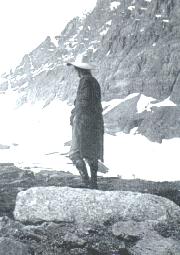
Photo: Samuel Allen (courtesy Whyte Archives)
Samuel Allen
(1874-1945) Samuel E. S. Allen was born in Philadelphia. A very intelligent man, he passed the Yale entrance exam at the age of sixteen and held a masters degree by the time he was twenty. Allen had ascended the Matterhorn and a number of other peaks in the Alps prior to becoming one of the first to explore the Lake Louise area. He first visited the Canadian Rockies in 1891, visiting Illecillewaet neve, Emerald Lake, the fossil beds on Mount Stephen and Lake Louise where he named and climbed the Devil's Thumb. After visiting the Alps and climbing the Matterhorn the following year, he returned to the Rockies in 1893, meeting Walter Wilcox in Banff. Allen climbed Mount Rundle and, together with Wilcox, climbed Fairview Mountain and made two unsuccessful attempts to climb the north peak of Mount Victoria, being turned back by avalanches below the Victoria-Collier notch. By 1890 the first small "Chalet" had been built near the shores of Lake Louise. When Allen and Wilcox arrived in 1893, it had just burned down, and they were forced to camp in what they described as, "a muskeg filled with mosquitos and tree stumps." In 1894, in the company of other Yale University students Allen, Walter Wilcox, and three others paid $12 per week for accommodation, meals, and the use of horses and a boat. Allen and Wilcox had both visited the area before and had failed in attempts to climb Mount Victoria and Mount Temple. But they had big plans for the summer of 1894 and returned with a better equipped expedition which included other students from Yale. They referred to themselves as the Lake Louise Club and were bent on exploring, climbing and mapping in what was then uncharted wilderness. Although inexperienced in the techniques of mountaineering, the group set out to climb Mount Lefroy. A large boulder was dislodged, striking Louis Frissell and seriously injuring him. A doctor travelled from Banff by handcar on the railway and the young man recovered in hospital. Following this near disaster, the "club" focused on lower altitude explorations discovering Paradise Valley and Wenkchemna Valley (The Valley of the Ten Peaks). They also completed first ascents of two easier peaks, Mount Aberdeen and Mount Temple where, "Many a hearty cheer rent the thin air as our little party of three reached the summit, for we were standing where no man had ever stood before, and...at the highest altitude yet reached in North America north of the United States boundary." Despite the successful ascent of Mount Temple, the group's inexperience in climbing had been demonstrated on Mount Lefroy and through the summer their limitations regarding glacier travel and cooking (one of the group recalled forty years later that he, "still remembered that stomach ache") led to other near disasters. But they persevered and when the club's members returned to their homes in the eastern United States, they had explored over one hundred square kilometres of country around Lake Louise. As well, the group chose the names of many of the lakes and mountains in the area, made a detailed map, and measured the depth of Lake Louise. A major contribution was "Camping in the Canadian Rockies," which was written by Walter Wilcox. The first major book about the Rockies, it was to inspire many others to explore and climb in the Canadian Rockies. "No scene has ever given me an equal impression of inspiring solitude and rugged grandeur." This was Walter Wilcox's reaction when he was one of the first visitors to the Valley of the Ten Peaks. In 1894 his companion, Samuel Allen, had chosen to name the peaks from east to west using the numbers from the Stoney Indian language as follows: Heejee, Nom, Yamnee, Tonsa, Sapta, Shappee, Sagowa, Saknowa, Neptuak, and Wenkchemna. A number of Stoney Indians had been hired to look after the horses used by Wilcox and his group and Allen must have learned the numbers from them. All but two of the peaks have subsequently been renamed to honour a variety of individuals. In September of 1894, Allen made a most impressive solo trip over Wenkchemna Pass, visiting the Eagle Eyrie and reaching Opabin Pass from where he named Mount Biddle, Mount Huber, and Ringrose Peak. Later in that same year he visited the Lake O'Hara area and, together with Yule Carryer, an Indian student from the University of Toronto, became the first to reach Abbot Pass. The following day Allen and Carryer climbed to the col now known as Wiwaxy Gap from which Allen enjoyed, "the most consummate view, from an artistic view, that I have ever seen in the Rockies." Samuel Allen returned to the Rockies for the last time in 1895, travelling to the Mount Assiniboine area. Unfortunately he then suffered mental problems and was confined to an institution for the remainder of his life, never to know that one of the finest peaks in the Valley of the Ten Peaks had been renamed in his honour. Of Samuel Allen, writer and historian Jon Whyte wrote that he was, "a haunting figure. Brightly intelligent, active and alert, alive to the nuances of language, a scholar and the finest namer of places the Rockies hasve ever hosted." Walter Wilcox wrote, "He was moody and loved solitude, studying the mountains in their details all day long with a pair of glasses. . . His best work was the crossing of Opabin Pass and his exporations around Lake O'Hara. [See Mount Allen] [Additional Information: Wilcox, Walter D. "Camping in the Canadian Rockies". New York: G.P. Putnam's Sons, 1897] [Additional Information re Wilcox and Allen: Eternal Lake O'Hara by Carol Ann Sokoloff pg. 20-26] [Additional Information: "Yoho: A History and Celebration of Yoho National Park" by Robert W. Sanford] [Additional Information: "Summit Tales" by Graeme Pole]